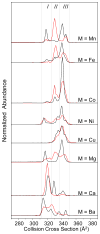Populations of metal-glycan structures influence MS fragmentation patterns
- PMID: 25315458
- PMCID: PMC4276451
- DOI: 10.1007/s13361-014-1000-2
Populations of metal-glycan structures influence MS fragmentation patterns
Abstract
The structures and collision-induced dissociation (CID) fragmentation patterns of the permethylated glycan Man5GlcNAc2 are investigated by a combination of hybrid ion mobility spectrometry (IMS), mass spectrometry (MS), and MS/MS techniques. IMS analysis of eight metal-adducted glycans ([Man5GlcNAc2 + M](2+), where M = Mn, Fe, Co, Ni, Cu, Mg, Ca, and Ba) shows distinct conformer patterns. These conformers appear to arise from individual metals binding at different sites on the glycan. Fragmentation studies suggest that these different binding sites influence the CID fragmentation patterns. This paper describes a series of separation, activation, and fragmentation studies that assess which fragments arise from each of the different gas-phase conformer states. Comparison of the glycan distributions formed under gentle ionization conditions with those obtained after activation of the gas-phase ions suggests that these conformer binding states also appear to exist in solution.
Figures





References
-
- Helenius A. Intracellular Functions of N-Linked Glycans. Science. 2001;291:2364–2369. - PubMed
-
- Dwek RA. Glycobiology. Toward Understanding the Function of Sugars. Chem Rev. 1996;96:683–720. - PubMed
-
- Thu B, Skjåk-Bræk G, Micali F, Vittur F, Rizzo R. The Spatial Distribution of Calcium in Alginate Gel Beads Analysed by Synchrotron-Radiation Induced X-ray Emission (SRIXE) Carbohydr Res. 1997;297:101–105.
-
- Müthing J, Maurer U, Weber-Schürholz S. Glycosphingolipids of Skeletal Muscle: II. Modulation of Ca2+-Flux in Triad Membranes by Gangliosides. Carbohydr Res. 1998;307:147–157. - PubMed
Publication types
MeSH terms
Substances
Grants and funding
LinkOut - more resources
Full Text Sources
Other Literature Sources

